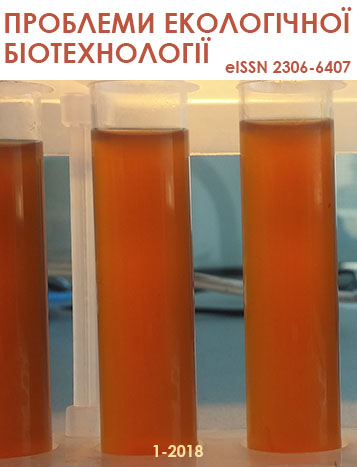Prognostic value of early reduction of BCR/ABL1 gene expression in criteria of deep molecular response on imatynib therapy in patients with chronic myeloid leukemia
DOI:
https://doi.org/10.18372/2306-6407.1.12851Keywords:
chronic myeloid leukemia, BCR/ABL1, deep molecular response, tyrosine kinase inhibitors, prognostic factorsAbstract
Achieving a deep molecular response (MR4) is a prerequisite for imatinib therapy discontinuation in patients with chronic myeloid leukemia (CML). 313 patients with a chronic phase of CML at the age from 18 to 80 years (Me = 42 years) were examined to determine the range of informative early criteria that will allow to select patients with a high probability of MR4 by 24 months of imatinib therapy. The prediction value of the BCR/ABL1 transcript level at 3 months and 6 months of imatinib therapy and initial clinical-laboratory and demographic factors were analyzed (age, sex, risk group for Sokal, Hasford, EUTOS and ELTS systems, duration of therapy before imatinib and BCR/ABL1 transcript type). By multivariate analysis, the type of BCR/ABL1 transcript (p = 0.045) and the duration of therapy before imatinib (p = 0.006) were the initial independent predictors of a deep molecular response at 24 months. The BCR/ABL1 transcript level at 3 months and 6 months were also significantly associated with the reduction of the tumor clone to the level of MR4 at 24 months of therapy. The threshold for the BCR/ABL1 transcript level was determined to be 3.7 % at 3 months and BCR/ABL1 = 0.4 % at 6 months. The excess of these threshold increased the risk of deep molecular response failure at 24 months. It is shown that the inclusion the BCR/ABL1 < 3.7 % at 3 months as an additional factor significantly increased the accuracy of prognosis the MR4 at 24 months and eliminated the importance of other prognostic factors.
References
Analysis of genomic breakpoints in p190 and p210 BCR-ABL indicate distinct mechanisms of formation / J. Score, M. J. Calasanz, O. Ottman [et al.] // Leukemia. – 2010. – Vol. 24, № 10. – P. 1742–1750.
International randomized study of interferon vs. STI571 (IRIS) 8-year follow-up: sustained survival and low risk for progression or events in patients with newly diagnosed chronic myeloid leukemia in chronic phase (CML-CP) / M. Deininger, S. G. O’Brien, F. Guilhot [et al.] // Blood. – 2009. – Vol. 114, № 22. – Abstract 1126. – P. 462.
GIMEMA. Health-related quality of life in chronic myeloid leukemia patients receiving long-term therapy with imatinib compared with the general population / F. Efficace, M. Baccarani, M. Breccia [et al.] // Blood. – 2011. – Vol. 118, № 17. – P. 4554–4560.
The concept of treatment-free remission in chronic myeloid leukemia / S. Saußele, J. Richter, A. Hochhaus, F. X. Mahon // Leukemia. – 2016. – Vol. 30, № 8. – P. 1638–1647.
Прогностичні фактори відповіді на терапію інгібіторами тирозинкіназ в українській когорті пацієнтів з хронічною мієлоїдною лейкемією / І. Дмитренко, І. Дягіль, Ж. Мінченко [та ін.] // Вісник Київського національного університету імені Тараса Шевченко. Серія: Проблеми регуляції фізіологічних функцій. – 2018. – № 24. – C. 17–24.
Прогностические факторы, ассоциированные с достижением глубокого молекулярного ответа на терапию иматинибом у пациентов с хронической миелоидной лейкемией / И. В. Дмитренко, В. Г. Федоренко, Т. Ю. Шляхтиченко [та ін.] // Гематология Трансфузиология. Восточная Европа. – 2017. – Т. 3, № 2. – С. 182–192.
Prognosis of long-term survival considering disease-specific death in patients with chronic myeloid leukemia / M. Pfirmann, M. Baccarani, S.Saussele [et al.] // Leukemia. – 2016. –Vol. 30, N 1. –P. 48-56.
Prognostic discrimination in “good-risk” chronic granulocytic leukemia / JE Sokal, EB Cox, M Baccarani [et al.] // Blood. – 1984. –Vol. 63, N 4. – P. 789–799.
Writing Committee for the Collaborative CML Prognostic Factors Project Group. A new prognostic score for survival of patients with chronic myeloid leukemia treated with interferon alfa / J. Hasford, M. Pfirrmann, R. Hehlmann [et al.] // J Natl Cancer Inst. – 1998. – Vol. 90, N 11. – P. 850–858.
Standardized RT-PCR analysis of fusion gene transcripts from chromosome aberrations in acute leukemia for detection of minimal residual disease/ J. J. van Dongen, E. A. Macintyre, J. A. Gabert [et al.] // Leukemia. – 1999. – Vol. 13, № 12. – P. 1901–1928.
European LeukemiaNet recommendationsfor the management of chronic myeloid leukemia: 2013 / M. Baccarani, M. W. Deininger, G. Rosti [et al.] // Blood. – 2013. – Vol. 122, № 6. – P. 872–884.
Применение множественного логистического регрессионного анализа в здравоохранении c использованием пакета статистических программ SPSS / Е.Е. Шарашова, К.К. Холматова, М.А. Горбатова, А.М. Гржибовский / Наука и Здравоохранение. – 2017. – №4. – С. 5–26.


